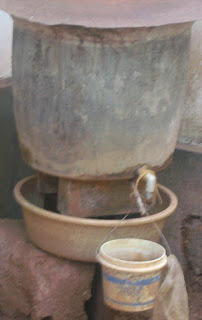
Vermicompost is an earth worm based waste degrading system, which can be easily setup in houses with a reasonable cost. Most popular earth worm species used for this purpose are Brandling Worms (Eisenia foetida), Redworms (Lumbricus rubellus) and Eudrilus eugeniae. We have setup a small vermicompost system at our home using Eudrilus eugeniae earth worm species. They cost 500 rupees for one kilogram.
Let’s discuss the construction, factors to be noted and maintenance of the system.
Container: It can be plastic, earth pot (best), cement pot, metal etc. Idea is the container shouldn’t contaminate the system, or shouldn’t degrade and produce toxic substances which will kill the worms. Problem with plastic containers will be, container become too hot during summer days that can seriously affect worm’s life.
Size and Shape: If the container is in rectangular shape, recommended size is max, two foot height, 3 foot width and there is no restriction for the length. If the container is round in shape, it can have a diameter of half meter.
Construction: Form a bed of basic layer using dried coconut husk (chakiri) in the container, next layering is with cow dung [optional] and then put the earth worms over that. Don’t use any mud or sand. Provide a tap to discharge vermiwash out of the container. Provide a barrier using water to prevent ants and other creatures entering the container. Initial weight of the waste, charging to the container is to be of half the weight of the worms. That is if you put one kilogram earth worm, initial waste can weigh 500 grams. Once they stabilize you can put waste of the same weight as that of worms.
Cover the top of the container with a chicken net, to prevent rat and other creatures entering the container. This will also help to provide sufficient aeration. Below picture shows a simple vermicompost structure.
Let’s discuss the construction, factors to be noted and maintenance of the system.
Container: It can be plastic, earth pot (best), cement pot, metal etc. Idea is the container shouldn’t contaminate the system, or shouldn’t degrade and produce toxic substances which will kill the worms. Problem with plastic containers will be, container become too hot during summer days that can seriously affect worm’s life.
Size and Shape: If the container is in rectangular shape, recommended size is max, two foot height, 3 foot width and there is no restriction for the length. If the container is round in shape, it can have a diameter of half meter.
Construction: Form a bed of basic layer using dried coconut husk (chakiri) in the container, next layering is with cow dung [optional] and then put the earth worms over that. Don’t use any mud or sand. Provide a tap to discharge vermiwash out of the container. Provide a barrier using water to prevent ants and other creatures entering the container. Initial weight of the waste, charging to the container is to be of half the weight of the worms. That is if you put one kilogram earth worm, initial waste can weigh 500 grams. Once they stabilize you can put waste of the same weight as that of worms.
Cover the top of the container with a chicken net, to prevent rat and other creatures entering the container. This will also help to provide sufficient aeration. Below picture shows a simple vermicompost structure.
Temperature and moisture: Temperature has to be between 20 to 29 degrees. Good moisture content has to be ensured in the container. Pour water depending on the need.
Bedding and how to put the wastes: Bedding means the living medium for the worms. Earth worms can degrade kitchen waste, paper [ensure that your papers don’t contain toxic elements like coated foils etc] cloths (degradable – cotton), dried leaves, remains of meat etc. Basically we can put all degradable substances. Dumping waste directly to the system is not advised, else keep the waste in your waste basket for one day, and let it soften. To reduce odor from the container, add both green matter (nitrogen conteant) and brown matter [carbon content- paper and dried leaves] to the container. Adding carbon will reduce degradation considerably.
Usage of Vermiwash and compost: Vermiwash is a good fertilizer with rich enzymes content than can be sprayed directly on leaves. Vegetable plants and ornamental plants will absorb this very fast since their leaves are soft. Spraying Vermiwash will increase colour of flowers. Vermicompost can be applied like any fertilizer for all plants.
Bedding and how to put the wastes: Bedding means the living medium for the worms. Earth worms can degrade kitchen waste, paper [ensure that your papers don’t contain toxic elements like coated foils etc] cloths (degradable – cotton), dried leaves, remains of meat etc. Basically we can put all degradable substances. Dumping waste directly to the system is not advised, else keep the waste in your waste basket for one day, and let it soften. To reduce odor from the container, add both green matter (nitrogen conteant) and brown matter [carbon content- paper and dried leaves] to the container. Adding carbon will reduce degradation considerably.
Usage of Vermiwash and compost: Vermiwash is a good fertilizer with rich enzymes content than can be sprayed directly on leaves. Vegetable plants and ornamental plants will absorb this very fast since their leaves are soft. Spraying Vermiwash will increase colour of flowers. Vermicompost can be applied like any fertilizer for all plants.
1 comment:
Thanks for this post. Expect more. You can start a thread for this kind of information is solidarity community. If you find any useful links for this kind of information, post it.
Post a Comment